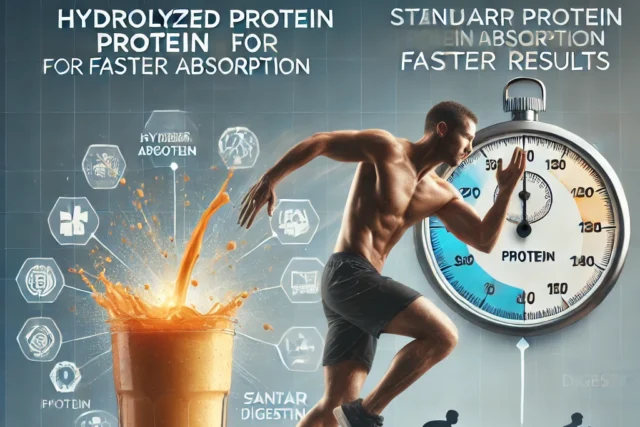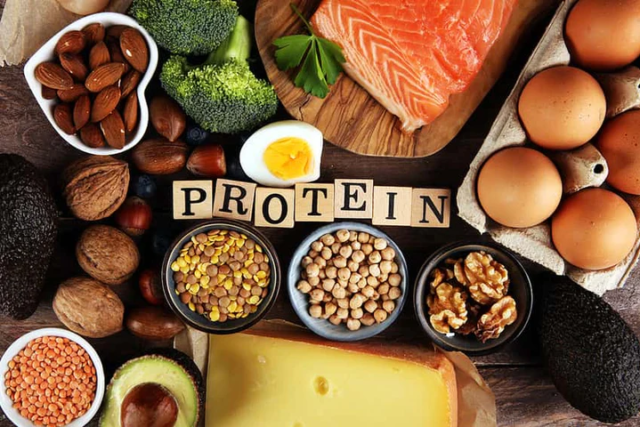Introduction
Protein plays a pivotal role in our body’s daily functions, from building and repairing tissues to producing essential enzymes and hormones. For those looking to maximize muscle growth, enhance recovery, or improve overall health, the type of protein you consume matters significantly. Enter hydrolyzed protein—a game-changer in the world of nutrition.
Unlike traditional protein sources, hydrolyzed protein undergoes a specialized process to make it easier for the body to absorb and utilize. This unique feature makes it a popular choice for athletes, fitness enthusiasts, and anyone seeking quick, tangible results. But what exactly is hydrolyzed protein, and why should you consider it? Let’s dive in.
Table of Contents
What is Hydrolyzed Protein?

Hydrolyzed protein is essentially protein that has been broken down into smaller peptides and amino acids through a process called hydrolysis. This process mimics digestion, pre-digesting the protein to make it faster and easier for the body to absorb.
Types of Hydrolyzed Protein
Hydrolyzed protein can be derived from various sources, including whey, casein, soy, or even collagen. Whey protein hydrolysate is the most common form, widely used in sports nutrition for its high bioavailability.
Comparison with Traditional Proteins
Traditional protein powders like whey concentrate or isolate require digestion before the body can use them. Hydrolyzed protein skips this step, allowing nutrients to be delivered to the muscles almost immediately after consumption.
How Hydrolyzed Protein Works
What makes hydrolyzed protein so effective? It all boils down to its structure and how the body processes it.
Role of Peptides and Amino Acids
Hydrolyzed protein consists of peptides—short chains of amino acids. These smaller molecules are absorbed more quickly by the bloodstream than their larger counterparts.
Faster Absorption Equals Faster Results
The quick uptake of amino acids accelerates muscle recovery, reduces fatigue, and provides almost immediate energy post-exercise.
Pre-Digested for Convenience
Because hydrolyzed protein is pre-digested, it places less strain on the digestive system, making it an ideal option for individuals with sensitive stomachs or digestion-related issues.
Benefits of Hydrolyzed Protein

Hydrolyzed protein isn’t just about speed—it offers a variety of health benefits that set it apart from other protein options.
Enhanced Muscle Recovery
After an intense workout, your muscles crave nutrients to repair and rebuild. Hydrolyzed protein delivers amino acids faster, helping you recover and return to training sooner.
Improved Digestion and Gut Health
Traditional proteins can cause bloating or discomfort in some individuals. Hydrolyzed protein’s pre-digested nature minimizes digestive strain, promoting gut health.
Faster Energy Replenishment
Its rapid absorption makes it a go-to choice for athletes who need a quick energy boost after demanding physical activity.
Lactose Intolerance-Friendly
Hydrolyzed whey protein contains minimal lactose, making it suitable for those who struggle with dairy-based proteins.
Hydrolyzed Protein vs. Traditional Protein
When deciding between hydrolyzed protein and other options like whey concentrate or casein, it’s essential to weigh the pros and cons.
Absorption Rate Comparison
Hydrolyzed protein is absorbed significantly faster than traditional proteins, which need to be digested before entering the bloodstream.
Muscle Building
While traditional proteins are effective for building muscle, hydrolyzed protein’s speedier delivery makes it more efficient for athletes and fitness enthusiasts aiming for quick recovery and muscle growth.
Effectiveness for Athletes
For high-performance athletes, time is of the essence. Hydrolyzed protein provides a strategic advantage by offering near-instant muscle support.
How to Use Hydrolyzed Protein
Maximizing the benefits of hydrolyzed protein requires knowing when and how to consume it.
Best Times to Consume
- Post-workout: For immediate muscle recovery.
- Pre-workout: For sustained energy and reduced muscle breakdown.
- Bedtime: For overnight muscle repair.
Dosage Recommendations
Most experts recommend 20-30 grams per serving, depending on your fitness goals and body weight.
Pairing with Other Nutrients
Combining hydrolyzed protein with carbohydrates post-workout can further accelerate glycogen replenishment and recovery.
Ideal Users for Hydrolyzed Protein

Hydrolyzed protein isn’t a one-size-fits-all solution. However, it serves specific groups exceptionally well, providing benefits tailored to their unique needs.
- Athletes and Bodybuilders
Athletes demand high-performance nutrition to fuel their training and recovery. Hydrolyzed protein’s rapid absorption ensures their muscles receive the necessary amino acids without delay, promoting faster recovery and reducing soreness. For bodybuilders, its ability to enhance muscle protein synthesis aids in building lean muscle mass, making it a cornerstone of their dietary regimen. - Individuals with Digestive Issues
People with sensitive digestive systems or conditions like lactose intolerance often struggle with traditional protein powders. Hydrolyzed protein, being pre-digested and lower in lactose, minimizes gastrointestinal discomfort, providing a hassle-free way to meet their protein needs. - Elderly Population
As people age, their protein requirements increase to maintain muscle mass and prevent age-related muscle loss (sarcopenia). Hydrolyzed protein’s easy digestibility and rapid action make it an ideal supplement for the elderly, ensuring they receive the nutrients their bodies need without taxing their digestive systems.
Potential Drawbacks of Hydrolyzed Protein
While hydrolyzed protein has many advantages, there are some downsides to consider.
Cost Considerations
Hydrolyzed protein is often more expensive than standard protein powders due to the advanced processing required to produce it. This cost can deter budget-conscious consumers despite its benefits.
Taste and Texture Challenges
The hydrolysis process can sometimes affect the taste and texture of the protein. Many people find hydrolyzed protein to have a slightly bitter flavor, which might take some getting used to.
Allergies and Sensitivities
Though hydrolyzed protein reduces lactose content, those with severe dairy allergies should exercise caution. Additionally, individuals allergic to soy, egg, or other protein sources should always read labels carefully to avoid adverse reactions.
Selecting the Right Hydrolyzed Protein
With numerous options available on the market, finding the right hydrolyzed protein can feel overwhelming. Here’s how to make an informed choice:
Key Ingredients to Look For
Look for hydrolyzed protein powders that list high-quality sources such as whey hydrolysate or hydrolyzed collagen. Avoid products with unnecessary fillers or artificial sweeteners.
Trusted Brands and Certifications
Choose reputable brands with certifications like NSF Certified for Sport or Informed-Sport. These certifications ensure the product is free from banned substances and contaminants, particularly important for athletes.
Avoiding Fillers and Additives
Some products contain excessive sugar, artificial flavors, or preservatives that detract from the protein’s benefits. Opt for clean, minimally processed options to ensure maximum nutritional value.
Recipes and Ways to Incorporate Hydrolyzed Protein

Incorporating hydrolyzed protein into your diet doesn’t have to be boring. Here are some creative ways to make the most of it:
- Smoothies and Shakes
Blend hydrolyzed protein with fruits, almond milk, spinach, and a dollop of nut butter for a nutrient-packed smoothie. This is a quick and delicious way to refuel post-workout. - Adding to Meals
Stir a scoop of unflavored hydrolyzed protein into oatmeal, soups, or pancake batter. This method boosts the protein content of your meals without altering their taste significantly. - Creative Snacks
Mix hydrolyzed protein into Greek yogurt, energy balls, or even homemade protein bars. These snacks are convenient, tasty, and rich in protein to keep you energized throughout the day.
The Role of Hydrolyzed Protein in Sports Nutrition
Hydrolyzed protein plays a crucial role in helping athletes achieve peak performance and maintain long-term health.
- Maximizing Performance
By delivering amino acids quickly, hydrolyzed protein supports muscle repair and growth, helping athletes perform at their best in training and competition. - Preventing Injuries
Regular consumption aids in maintaining muscle and joint health, reducing the risk of overuse injuries often experienced by active individuals. - Long-Term Health Benefits for Athletes
Beyond immediate performance gains, hydrolyzed protein supports overall health by improving recovery, enhancing immune function, and promoting sustained energy levels.
Myths About Hydrolyzed Protein
Let’s debunk some common myths and misunderstandings surrounding hydrolyzed protein:
- Common Misconceptions
Some believe hydrolyzed protein is only for bodybuilders or professional athletes. In reality, anyone seeking faster absorption and better digestion can benefit. - Clarifying the Facts
It’s often assumed that hydrolyzed protein is over-processed or less natural. However, the hydrolysis process simply mimics what the body does during digestion, making the protein more efficient. - Addressing Skepticism
Skeptics might question its benefits compared to regular proteins. Scientific studies consistently demonstrate that hydrolyzed protein’s rapid absorption gives it an edge, particularly for recovery and performance.
Research Supporting Hydrolyzed Protein
The science behind hydrolyzed protein is compelling:
- Scientific Studies and Findings
Research shows that hydrolyzed protein improves muscle protein synthesis rates compared to non-hydrolyzed forms, particularly after resistance training. - Real-World Examples
Many elite athletes incorporate hydrolyzed protein into their routines to optimize recovery and maintain performance levels during intense training cycles. - Expert Opinions
Nutritionists and sports scientists often recommend hydrolyzed protein for individuals needing rapid nutrient delivery, highlighting its efficiency and versatility.
Hydrolyzed Protein and Weight Loss

If weight loss is your goal, hydrolyzed protein can be a valuable tool:
- Role in Maintaining Lean Muscle
During calorie deficits, hydrolyzed protein helps preserve muscle mass, ensuring your body burns fat instead of muscle. - Boosting Metabolism
Protein has a high thermic effect, meaning your body burns more calories digesting it. Hydrolyzed protein’s quick absorption further enhances this effect. - Supporting Satiety
Consuming hydrolyzed protein helps you feel full longer, reducing the temptation to snack on unhealthy foods.
Future of Hydrolyzed Protein in Nutrition
As the demand for efficient nutrition solutions grows, hydrolyzed protein is poised to play a larger role in mainstream diets:
Emerging Trends
Innovations like plant-based hydrolyzed proteins are expanding its accessibility to vegans and vegetarians.
Innovations in Production
Advances in enzymatic hydrolysis are improving the flavor and texture of hydrolyzed protein products, making them more appealing.
Expansion into Mainstream Diets
As more people recognize its benefits, hydrolyzed protein is becoming a staple not just in fitness circles but in everyday nutrition.
Conclusion
Hydrolyzed protein is a powerful tool for anyone seeking faster results from their nutrition. Whether you’re an athlete aiming for peak performance, someone managing digestive issues, or just looking to enhance your overall health, hydrolyzed protein offers unparalleled benefits. Incorporating it into your diet can elevate your fitness and well-being.
Frequently Asked Questions
What is the main difference between hydrolyzed protein and regular protein?
Hydrolyzed protein is pre-digested, allowing for faster absorption compared to traditional proteins.
Can hydrolyzed protein help with weight loss?
Yes, it supports weight loss by preserving lean muscle, boosting metabolism, and enhancing satiety.
Is hydrolyzed protein safe for everyone?
Generally, yes. However, individuals with specific allergies should consult a doctor before use.
What are the best ways to use hydrolyzed protein in meals?
Add it to smoothies, oatmeal, or baked goods for a convenient protein boost.
Does hydrolyzed protein have side effects?
Side effects are rare but can include mild digestive discomfort or allergic reactions in sensitive individuals.



MOST COMMENTED
Animal-Based Proteins / Casein Protein / Dietary Protein / High-Protein Diets / Pea Protein / Plant-Based Proteins / Protein / Protein Deficiency / Protein Supplements / Proteins / Whey Protein / Whey Proteins
Is Protein Powder Safe for Teenagers and Children?
Animal-Based Proteins / Casein Protein / Dietary Protein / High-Protein Diets / Pea Protein / Plant-Based Proteins / Protein / Protein Deficiency / Protein Supplements / Proteins / Whey Protein / Whey Proteins
Unlock the Power of Proteins for Optimal Gut Health
Multivitamin
Total Health: Multivitamin for Active Lifestyles
Multivitamin
WellnessFusion: Complete Multivitamin Support
Dietary Supplement
Revitalize Your Health: The Magic of Red Yeast Rice Capsules
Foot care / Foot Health
Revitalize Your Foot Care Routine: Essential Tips for Optimal Foot Health
Foot Problem / Diabetics / Foot Health
Diabetics: Mastering Footwear Selection for Enhanced Foot Health and Ultimate Comfort
Exercises and Footwear Tips for Hammertoe Relief / Foot care / Foot Health / Foot Pain / Foot Problem / Hammertoes
Unlock Effective Exercises and Footwear Tips for Hammertoe Relief
Hammertoes / Foot Health / Foot Pain / Foot Problem
Unlock Relief: Essential Guide to Hammertoes Causes, Symptoms, and Treatments
Foot Problem / Foot Health
Revolutionize Your Recovery: Natural Remedies for Plantar Fasciitis – Fresh Home Keepers